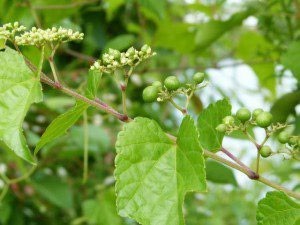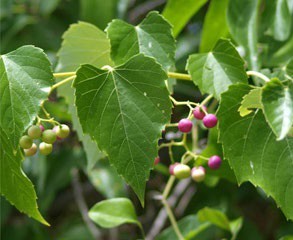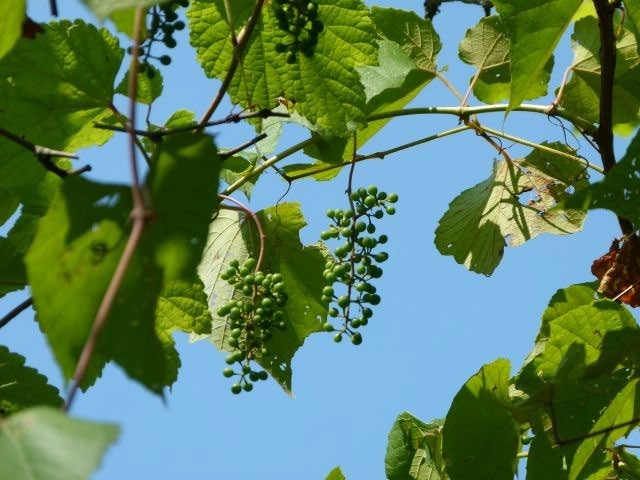
Porcelain berry, also commonly known as Amur peppervine, is a deciduous, woody, perennial vine in the grape family (Vitaceae), which closely resembles native species of grape in the genus Vitis. Porcelain berry vines can grow to be 15-20 ft long, twining around adjacent trees and structures with the help of non-adhesive tendrils. Its fruit is a distinctive speckled berry that ranges in color from blue, pink, purple, to cream. Porcelain berry is often confused not only with native grapes but also with its closer relatives in the genus Ampelopsis, such as native heart-leaved peppervine.
Background
Porcelain berry is native to northeast Asia and was originally introduced in the 1870s as a bedding and landscape plant. It is still cultivated and used in the U.S. horticultural trade, although it was recently declared a plant pest by the Vermont Department of Agriculture, Food and Markets. Under this current designation, the import, sale, or movement of porcelain berry is prohibited without a state permit. The characteristics that make porcelain berry a desirable landscape plant –colorful berries, dense ground coverage, trellis-climbing vines, pest-resistance, and tolerance to adverse conditions – are responsible for the perseverance of this undesirable introduced weed.
Habitat and Distribution
Porcelain berry grows in a variety of conditions and site types, but flourishes particularly well in moist soils such as forest edges, pond margins, stream banks, thickets, and disturbed areas, where there is full sunlight to partial shade and the ground is not permanently wet. It is less tolerant of heavily shaded areas such as mature forest understories. Porcelain berry is widespread in the eastern U.S. from New England to North Carolina and west to Michigan; it is considered to be invasive in twelve states in the Northeast, including neighboring Massachusetts and New York State. The website iNaturalist.org reports nine locations of porcelain berry in Vermont, three of which are research grade confirmed. Because of the reportedly limited and isolated distribution of this plant in our state, it has been identified as an early detection species on VTInvasives.org. Observations of porcelain berry are encouraged on the website’s Report It! page. Vigilance and reporting of introduced weeds is one of the best publicly available tools to promote the ecological health of our landscape.
Ecological Concern
Porcelain berry grows vigorously and with rapid speed in open and wooded habitats, in high to moderate light conditions. As it spreads, it climbs over and blankets existing plants and weakens/kills them by blocking sunlight. By shading out shrubs and young trees, it consumes habitat for native plants and animals. This alteration of habitat can lead to the loss of biodiversity and disrupt crucial ecological processes such as nutrient cycling. Because porcelain berry exhibits a high tolerance to a variety of environmental conditions, a variety of habitats could be threatened by this species. Additionally, the vine’s ability to climb and smother trees can interfere with timber production and reduce crop yields, with significant potential economic impacts on the agricultural and forest industries. In the US Forest Service's Eastern Region, porcelain berry is classified as a Category 1 invasive species. Plants in this category are "nonnative, highly invasive plants which invade natural habitats and replace native species".
Biology and Spread
Porcelain berry is a fast-growing liana (a woody, climbing or trailing plant that does not support its own weight), which spreads by seed and through vegetative means. Especially when rainfall is abundant, vines can grow up to 20 ft in a single growing season. Tiny flowers are inconspicuous, greenish white, and appear in June-August. The colorful fruits, each containing two to four seeds, appear in September-October, and are eaten by birds and other small animals that aid in seed dispersal. Seeds readily germinate and start new infestations after being spread by animal droppings. Porcelain berry is often found growing in riparian areas downstream from established patches, which suggests that water and flood events could also aid in dispersal. Porcelain berry plants have vigorous and deep root systems, which readily resprout after above-ground portions have been cut.
Identification
Stems: Perennial woody vine with a white stem pith (grape is brown), the bark has lenticels (grape does not), and the bark does not peel (grape bark peels/shreds). Tendrils grow opposite the leaves and have 2 or 3 branches.
Leaves: White shiny underneath with fine hairs, alternate on the stem, palmate, with coarsely toothed margins. Either heart-shaped or deeply lobed with 3-5 divisions, depending on the location along the stem.
Flowers: Inflorescence is an upward-facing, umbrella-shaped cyme with tiny, greenish white flowers, growing opposite the leaves on the stem. Contrast with grape inflorescence, which is tapered and droops down.
Fruits: 4-8 mm in diameter, circular, containing 2-4 seeds each. May be many colors present on the same plant, including green, blue, purple, pink, or cream, with black or brown speckles. Fruits appear late summer and fall.

Porcelain berry inflorescence in an upward facing cyme of tiny, greenish white flowers and immature fruit. Credit: Virginia Native Plant society
Management
Because porcelain berry vines grow rapidly and seeds may be viable in the soil for several years, treatment measures must be repeated during the season and for several years afterwards to fully eradicate the plant. Prevention of flowering, fruiting, and production of mature seeds is a critical step in preventing its spread.
Manual Removal
Hand pulling vines in the fall or spring will prevent flower buds from forming the following season. Where feasible, plants should be pulled up by hand before fruiting to prevent the production and dispersal of seeds. If the plants are pulled after fruits have matured, fruits should be bagged and disposed of in a landfill.
Chemical Removal
For vines too large to pull out, cut them near the ground and treat cut stems with systemic herbicides such as triclopyr and glyphosate. For foliar applications, the most effective control has been achieved using triclopyr formulations applied in summer to fall. Smaller infestations can be controlled to some extent with spot applications of glyphosate to leaves. Use herbicides sparingly and minimize drift to avoid contact with desirable plants. Use chemical control as only ONE piece of your prevention and management strategy. The label found on the herbicide container is the law. It indicates the concentrations to use, what PPE to wear, how to apply the product, and what environmental and human health hazards are associated with the chemical.
Native Lookalikes

Heartleaf peppervine (Ampelopsis cordata): Leaves broadly ovate, heart-shaped and less lobed than porcelain berry, with an extended tip. Credit: Brenda K.Loveless

Wild grape (Vitis riparia): Flowers and fruits droop downwards in tapered clusters. Shaggy bark peels in parallel lines. Brown pith in center of stem. Credit: Virginia Native Plant society